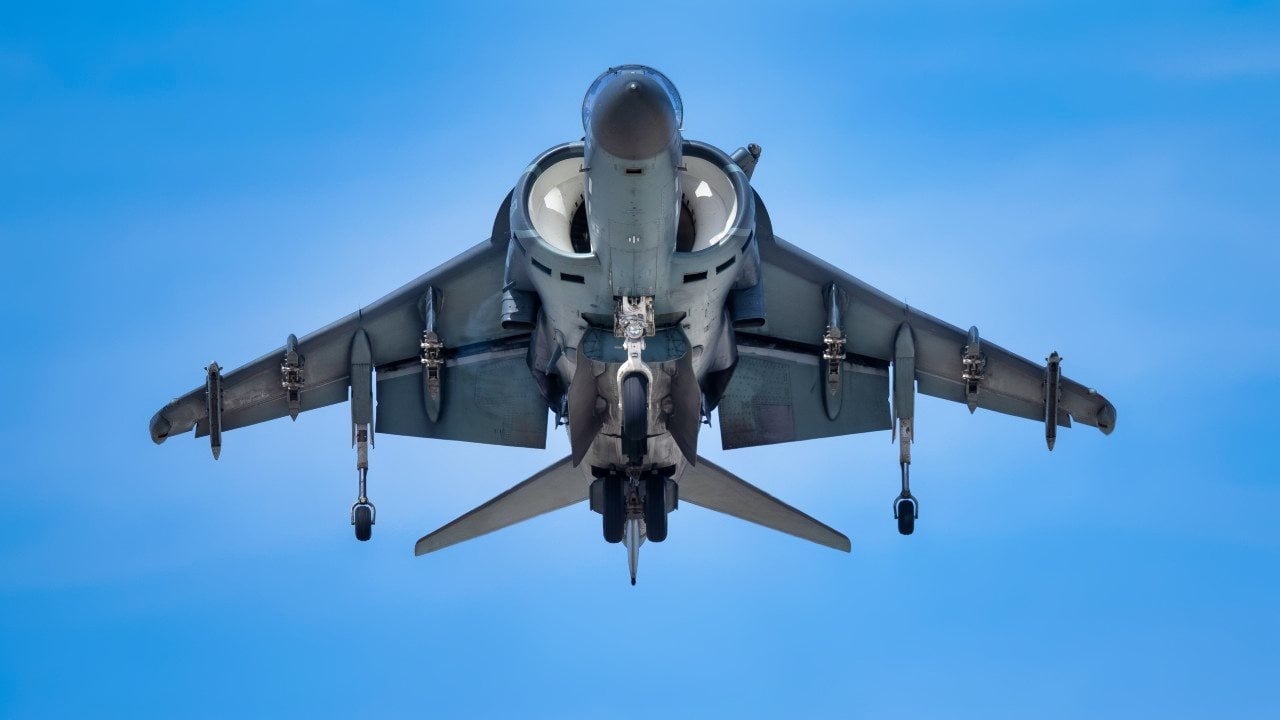
The AV-8B Harrier Fighter Takes No Prisoners
Summary: The AV-8B Harrier jet, a cornerstone of U.S. Marine Corps aviation for nearly four decades, is nearing its final flight.
-With its unique ability for vertical takeoff and landing, the Harrier has been pivotal in operations from the Gulf War to countering drone threats over the Red Sea.
-As the Marine Corps transitions its last pilots to the F-35B, the Harrier’s legacy of versatility and adaptability in combat and crisis situations endures, marking an era of significant advancement in military aviation technology and tactics.
End of an Era: The AV-8B Harrier Prepares for Its Final Mission
In its nearly 40 years of service, the AV-8B Harrier jet has provided close air support against Saddam Hussein’s military in Kuwait; intercepted Houthi drones over the Red Sea; and played a starring role in an iconic lawsuit against soda giant PepsiCo.
Now, even as it adapts to a new drone warfare role, it’s preparing to see its final battles.
In April, the Marine Corps’ last two Harrier pilots earned their wings of gold, marking the end of the 7509 military occupational specialty. Once expected to retire in 2025, the Harrier is now expected to fly until September 2026, when the remaining two Harrier squadrons will transition to housing the hovering jet’s spiritual child: the F-35B short takeoff and vertical lift (STOVL) Joint Strike Fighter.
“The significance of the last replacement pilot training flight in the Harrier community is that it is the beginning of the end for us as a community,” Capt. Joshua Corbett, who, along with Capt. Sven Jorgensen, is the last of the Harrier pilot tribe, said in a news release. “The Harrier, more than many aircraft [that] I have come across, elicits an emotional response. For members of the public, members of the aviation community, members of the Marine community, and especially members of the Harrier pilot community, it’s bittersweet. All good things have to come to an end, and it’s our turn soon, but not yet.”
A NEW KIND OF AIRCRAFT
As an amphibious force operating both on land and off ships, the Marines have long had unique aviation needs that conventional fighter jets couldn’t meet. As LA Times reported in 2002, the vision for a plane that would meet these needs was born out of World War II battles such as Guadalcanal and Tulagi that saw Marines depending on Navy defenses and sometimes suffering when those withdrew.
“The precept that Marines in the air should protect Marines on the ground has been central to the Corps’ ethos ever since,” the paper wrote.
Enter the Harrier jump jet. First developed for the British Royal Navy by Hawker-Siddeley, the single-engine fighter was the first to be able to conduct short takeoffs and vertical landings thanks to a turbofan with four rotating nozzles that can be pointed straight down to produce a powerful vertical thrust. This allows the aircraft to effectively hover, allowing it to take off and land with precision on a surface as small as an aircraft carrier or even smaller amphibious ships. The maneuver burns a fair amount of fuel – about a gallon every two seconds – but frees aircrews from the constraints of long runways, opening up a new range of operating environments.
After a series of early collaborations with British engineers, the Marine Corps started working on what would become the McDonnell Douglas AV-8B Harrier in 1976, battling budget issues and bureaucracy to bring it into service in 1985. At the start of the new decade, it would see its first major conflict.
BATTLE PROVEN
Harrier performance in the Gulf War got mixed reviews. Air and Space Forces Magazine reports that 84 Harriers turned in an impressive 3,400 sorties split between close air support and air interdiction missions. Five Harriers were lost in the conflict and two pilots killed, and the jet took criticism for being particularly vulnerable to enemy fire.
But, writing for Proceedings magazine in 1996, Retired Lt. Col. Theodore Herman, a career Marine aviator and McDonnell Douglas program manager, took issue with the guff.
“Virtually unknown to the general public, Marine Harriers were in the fray from beginning to end,” he wrote, arguing that the jets had functioned exactly as designed in battle. “They based close to the battle, on land and at sea, as they had always advertised they would, and delivered significant amounts of ordnance. Their missions were varied: battlefield air interdiction, helicopter escort, battlefield preparation, and close air support. Flying every mission for which they were tasked, they never required aerial refueling as they ranged over Kuwait.”
In any case, Harriers would have more chances to prove themselves in the wars that followed. Harriers were in the first waves of strikes against Afghanistan in November 2001, following the 9/11 attacks. They launched from 15th Marine Expeditionary Unit ships off the coast of Pakistan to deliver ordnance that month, and in December 2001, a Harrier squadron would deploy to the newly established forward base Kandahar to begin what would be two decades of close air support and strike missions.
In Operation Iraqi Freedom, the AV-8Bs turned amphibious ships into “Harrier Carriers,” allowing Marines to project greater power from Marine Expeditionary Units. Navy and Marine Corps officers wrote for Proceedings in 2004 that squadrons launched from the amphibious assault ships Bataan and Bonhomme Richard had spent more than 250 tons of ordinances and damaged or dispatched about 1,200 targets in the early days of the war.
FIGHTING PEPSI FOR A HARRIER
Harriers also got a few moments in the pop culture spotlight. Most notably, a 1995 commercial for a new Pepsi rewards program featured the jump jet hovering into a vertical landing outside a school, papers flying as a high school kid hops out of the cockpit.
“It sure beats the bus,” he quips.
What made the ad iconic – and a headache for Pepsi – was the chyron that rolled out under the jet onscreen: “7,000,000 Pepsi Points.”
Viewer John Leonard took that as an offer, and calculated it was actually a pretty good deal to boot. After finding out he could purchase Pepsi Points at a dime each, he sent PepsiCo 15 points labels, and a check for $700,008.50 to cover the remaining cost. When the soda company did not deliver him a Harrier, he sued for breach of contract and fraud. While Leonard lost his case, the decision by New York district Judge Kimba Wood made for some memorable reading.
“In light of the Harrier Jet’s well-documented function in attacking and destroying surface and air targets, armed reconnaissance and air interdiction, and offensive and defensive anti-aircraft warfare,” Wood wrote, “depiction of such a jet as a way to get to school in the morning is clearly not serious even if, as plaintiff contends, the jet is capable of being acquired “in a form that eliminates [its] potential for military use.”
He added that, “No school would provide landing space for a student’s fighter jet, or condone the disruption the jet’s use would cause.”
A 2022 Netflix series examines the story in detail. Unchastened, Pepsi would later re-release the commercial, but with an updated chyron requiring 700 million Pepsi Points for a Harrier.
DRONE DEFENDER
As the Harrier continues its twilight tour – VMA-223, the Bulldogs, out of Cherry Point, NC, will be last to transition fully to the F-35 in 2026 – it’s demonstrating that an old jet can still learn new tricks. Harriers deployed aboard the Bataan in the Red Sea have played a role in countering suicide attack drones deployed by Iran-back Houthi rebels based off the coast of Yemen.
According to a BBC interview with Harrier pilot Capt. Earl Ehrhart, at least one Harrier has been “modified” for air defense, loading it with missiles. The Harrier has seven hardpoints and is capable of carrying 9,200 pounds worth of ordnance, though its thirsty fuel needs often require a tradeoff between gas and bombs. It’s also capable of carrying the GAU-12 Equalizer 125mm five-barrel cannon when the mission requires it.
It’s not fully clear what the extent of the Harrier’s anti-drone activity has been, but Ehrhart said he’d personally intercepted seven of the drones.
The Harrier doesn’t win beauty awards, and its screaming fans keep it from ever sneaking up on a target. But it introduced the STOVL concept to the Marine Corps – a capability preserved in the F-35B that is replacing it.
And for the Marine Corps, as one general is said to have put it, that made the plane “an answer to a prayer.”
About the Author
Hope Hodge Seck is an award-winning investigative and enterprise reporter who has been covering military issues since 2009. She is the former managing editor for Military.com.
This article was first published by Sandboxx News.


